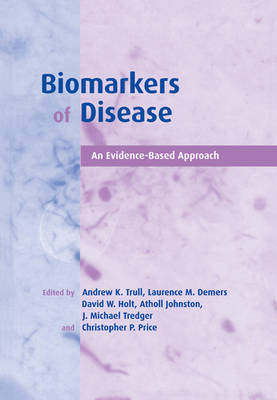
Biomarkers of Disease
Cambridge University Press (Verlag)
978-0-521-08860-2 (ISBN)
This publication takes a critical, evidence-based look at the efficacy of diagnostic tests which are increasingly being used to evaluate organ damage and dysfunction. The use of biomarkers is growing, with a steady stream of products being brought out by the pharmaceutical industry. Some of these assist in diagnosis, others provide a means of monitoring the state of progression of disease and the effectiveness of therapeutic options. However, in many cases the evidence which supports the use of these methods as opposed to traditional biochemical tests has not yet been demonstrated, and it is intended that this volume will help clarify the strengths and weaknesses of using these biomarkers across a wide range of applications and in the various organs of the body. This approach will provide pathologists, clinical biochemists and medical laboratory scientists with an invaluable overview of the diverse applications of biomarkers in medicine.
Part I. Assessing and Utilising the Diagnostic and Prognostic Power of Biomarkers: 1.1. Evidence-based medicine: evaluation of biomarkers; 1.2.Development of biomarkers - the industrial perspective; 1.3. Statistical approaches to rational biomarker selection; 1.4. Using intelligent systems in clinical decision support; Part II. Biomarkers of Kidney Disease and Dysfunction: 2.1. Biomarkers in renal disease; 2.2. The genetics of renal disease; 2.3. Early markers of nephrotoxicity for environmental and occupational monitoring; 2.4. The early detection of renal impairment in diabetes mellitus; Part III. Biomarkers of Bone Disease and Dysfunction: 3.1. Bone turnover markers in clinical practice; 3.2. Biomarkers of bone formation; 3.3. Biochemical markers of bone resorption; 3.4. The clinical application of biomarkers in osteoporosis; 3.5. Sources of pre-analytical variability in the measurement of biochemical markers of bone turnover; 3.6. Genetic approaches to the study of complex diseases: osteoporosis; Part IV. Biomarkers of Liver Disease and Dysfunction: 4.1. Biomarkers of hepatic disease; 4.2. The immunogenetics of metabolic liver disease; 4.3. Toxicogenetics of liver dysfunction; 4.4. Prognosis and management of patients with acute liver failure; 4.5. Biomarkers in artificial and bioartificial support; 4.6. Prognostic markers in liver disease; 4.7. Apoptosis: biomarkers and the key role of mitochondria; 4.8. Liver regeneration: mechanism and markers; 4.9. Determinants of response to viruses and self in liver disease; 5.0 IL-6-type cytokines and signalling in inflammation; Part V. Biomarkers of Gastrointestinal Disease and Dysfunction: 5.1. Biomarkers in gastrointestinal disease; 5.2. Tumour markers in gastrointestinal disease; 5.3. Markers of malabsorption: coeliac disease; Part VI. Biomarkers in Toxicology: 6.1. Genomics and biomarkers in toxicology; 6.2. Protein profiling and proteomic databases; 6.3. Biomarkers for evaluating the safety of genetically modified foods; Part VII. Biomarkers of Cardiovascular Disease and Dysfunction: 7.1. The impact of biochemical tests on patient management; 7.2. Cardiac naturetic peptides in risk assessment of patients with acute myocardial infarction or congestive heart failure; 7.3. Serum markers of inflammation and cardiovascular risk; 7.4. The clinical significance of markers of coagulation in acute coronary syndromes; 7.5. Endothelin - what does it tell us about myocardial and endothelial dysfunction?; 7.6. Homocysteine - a reversible risk factor for coronary heart disease; 7.7. Matrix metalloproteinases and their tissue inhibitors; Part VIII.. Biomarkers of Neurological Disease and Dysfunction: 8.1. Biomarkers of neurodegenerative disorders; 8.2. Traumatic brain injury: assessment by biochemical serum markers; 8.3. An overview of S-100beta as a clinically useful biomarker of brain tissue damage; Part IV. Biomarkers in Transplantation: 9.1. Monitoring heart and lung transplant recipients Marlene Rose; 9.2. Monitoring liver transplant recipients; 9.3. Chronic allograft damage index as surrogate marker for chronic allograft rejection; 9.4. Advances in pharmacodynamic biomarkers for monitoring the response to immunosuppressive drug therapy; 9.5. The use of biomarkers for monitoing the response to immunosuppressive drug therapy; 9.6. Post-transplantation bone disease; 9.7. Molecular diagnosis of cytomegalovirus diseases; 9.8. Diagnosis and monitoring of inflammatory events in transplant recipients; Index.
| Erscheint lt. Verlag | 30.10.2008 |
|---|---|
| Zusatzinfo | 52 Tables, unspecified; 6 Halftones, unspecified; 56 Line drawings, unspecified |
| Verlagsort | Cambridge |
| Sprache | englisch |
| Maße | 156 x 230 mm |
| Gewicht | 820 g |
| Themenwelt | Studium ► 2. Studienabschnitt (Klinik) ► Pathologie |
| ISBN-10 | 0-521-08860-7 / 0521088607 |
| ISBN-13 | 978-0-521-08860-2 / 9780521088602 |
| Zustand | Neuware |
| Haben Sie eine Frage zum Produkt? |
aus dem Bereich


